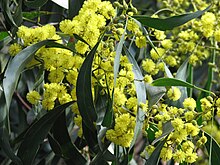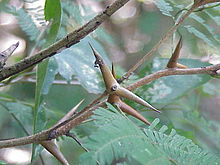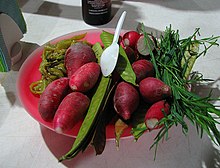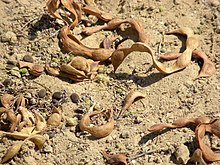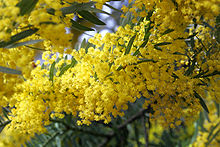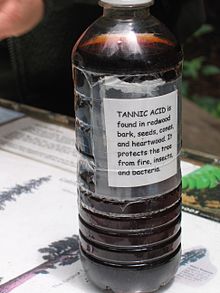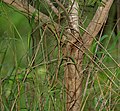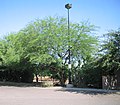You are here
Leguminosae
Acacia Mill.
EOL Text
Acacia (pronounced /əˈkeɪʃə/) is a genus of shrubs and trees belonging to the subfamily Mimosoideae of the family Fabaceae, first described in Africa by the Swedish botanist Carl Linnaeus in 1773. Many non-Australian species tend to be thorny, whereas the majority of Australian acacias are not. They are pod-bearing, with sap and leaves typically bearing large amounts of tannins and condensed tannins that historically in many species found use as pharmaceuticals and preservatives.
The generic name derives from ακακία (akakia), the name given by early Greek botanist-physician Pedanius Dioscorides (ca. 40-90) to the medicinal tree A. nilotica in his book Materia Medica.[2] This name derives from the Greek word for its characteristic thorns, ακις (akis, thorn).[3] The species name nilotica was given by Linnaeus from this tree's best-known range along the Nile river.
Acacias are also known as thorntrees, whistling thorns or wattles, including the yellow-fever acacia and umbrella acacias.
Until 2005, there were thought to be roughly 1300 species of acacia worldwide, about 960 of them native to Australia, with the remainder spread around the tropical to warm-temperate regions of both hemispheres, including Europe, Africa, southern Asia, and the Americas. However, the genus was then divided into five, with the name Acacia retained for the Australian species (and a few in tropical Asia, Madagascar and Pacific Islands), and most of the species outside Australia divided into Vachellia and Senegalia. The two final genera, Acaciella and Mariosousa, only contain about a dozen species from the Americas each.
Contents |
//
Classification
The genus Acacia is evidently not monophyletic. This discovery has led to the breaking up of Acacia into five new genera as discussed in: List of Acacia species. In common parlance, the term "acacia" is occasionally misapplied to species of the genus Robinia, which also belongs in the pea family. Robinia pseudoacacia, an American species locally known as Black Locust, is sometimes called "false acacia" in cultivation in the United Kingdom.
Geography
The southernmost species in the genus are Acacia dealbata (Silver Wattle), Acacia longifolia (Coast Wattle or Sydney Golden Wattle), Acacia mearnsii (Black Wattle), and Acacia melanoxylon (Blackwood), reaching 43°30' S in Tasmania, Australia, while Acacia caven (Espinillo Negro) reaches nearly as far south in northeastern Chubut Province of Argentina. Australian species are usually called wattles, while African and American species tend to be known as acacias.
Acacia albida, Acacia tortilis and Acacia iraqensis can be found growing wild in the Sinai desert and the Jordan valley. It is found in the savanna vegetation of the tropical continental climate. It grows wild in Montserrat West Indies; there it is locally referred to as 'cusha.'
Description
The leaves of acacias are compound pinnate in general. In some species, however, more especially in the Australian and Pacific islands species, the leaflets are suppressed, and the leaf-stalks (petioles) become vertically flattened, and serve the purpose of leaves. These are known as phyllodes. The vertical orientation of the phyllodes protects them from intense sunlight, as with their edges towards the sky and earth they do not intercept light so fully as horizontally placed leaves. A few species (such as Acacia glaucoptera) lack leaves or phyllodes altogether, but possess instead cladodes, modified leaf-like photosynthetic stems functioning as leaves.
The small flowers have five very small petals, almost hidden by the long stamens, and are arranged in dense globular or cylindrical clusters; they are yellow or cream-colored in most species, whitish in some, even purple (Acacia purpureapetala) or red (Acacia leprosa Scarlet Blaze). Acacia flowers can be distinguished from those of a large related genus, Albizia, by their stamens which are not joined at the base. Also, unlike individual Mimosa flowers, those of Acacia have more than 10 stamens.[4]
The plants often bear spines, especially those species growing in arid regions. These sometimes represent branches which have become short, hard and pungent, or sometimes leaf-stipules. Acacia armata is the Kangaroo-thorn of Australia and Acacia erioloba is the Camelthorn of Africa.
Acacia seeds can be difficult to germinate. Research has found that immersing the seeds in various temperatures (usually around 80 °C) and manual seed coat chipping can improve yields to approximately 80 percent.[5]
Symbiosis
In the Central American Acacia sphaerocephala, Acacia cornigera, and Acacia collinsii (collectively known as the bullthorn acacias), the large thorn-like stipules are hollow and afford shelter for several species of Pseudomyrmex ants, which feed on a secretion of sap on the leaf-stalk and small, lipid-rich food-bodies at the tips of the leaflets called Beltian bodies. In return, the ants add protection to the plant against herbivores.[6] Some species of ants will also fight off competing plants around the acacia, cutting off the offending plant's leaves with their jaws and ultimately killing it. Other associated ant species appear to do nothing to benefit their hosts.
Similar mutualisms with ants occur on Acacia trees in Africa, such as the Whistling Thorn acacia. The acacias provide shelter for ants in the thorns and nectar in extrafloral nectaries for their symbiotic ants such as Crematogaster mimosae. In turn, the ants protect the plant by attacking large mammalian herbivores and stem-boring beetles that damage the plant.
Pests
In Australia, Acacia species are sometimes used as food plants by the larvae of hepialid moths of the genus Aenetus including A. ligniveren. These burrow horizontally into the trunk then vertically down. Other Lepidoptera larvae which have been recorded feeding on Acacia include Brown-tail, Endoclita malabaricus and Turnip Moth. The leaf-mining larvae of some bucculatricid moths also feed on Acacia: Bucculatrix agilis feeds exclusively on Acacia horrida and Bucculatrix flexuosa feeds exclusively on Acacia nilotica.
Acacias contain a number of organic compounds that defend them from pests and grazing animals.[7]
Uses
Food uses
Acacia seeds are often used for food and a variety of other products.
In Burma, Laos and Thailand, the feathery shoots of Acacia pennata (common name cha-om, ชะอม and su pout ywet in Burmese) are used in soups, curries, omelettes, and stir-fries.
Honey made by bees using the acacia flower as forage is considered a delicacy, appreciated for its mild flowery taste, soft running texture and glass-like appearance. Acacia honey is one of the few honeys which does not crystallize.[8]
In Mexico the seeds are known as Guajes. Guajes or huajes are the flat, green pods of an acacia tree. The pods are sometimes light green or deep red in color—both taste the same. Guaje seeds are about the size of a small lima bean and are eaten raw with guacamole, sometimes cooked and made into a sauce. They can also be made into fritters. The ground seeds are used to impart a slightly garlicy flavor to a mole called guaxmole (huaxmole). The dried seeds may be toasted and salted and eaten as a snack referred to as "cacalas". Purchase whole long pods fresh or dried at Mexican specialty markets.
The first-known predominantly vegetarian spider Bagheera kiplingi, which is found in Central America and Mexico, was first documented and filmed in 2009 feeding from the tips of the acacia plants which are known as Beltian bodies which contain high concentrations of protein. All other 40,000 known species of spider's diets are mainly believed to be carnivorous.
Acacia is listed as an ingredient in Sun Drop, Fresca, a citrus soft drink, RC Cola, Barq's root beer, Full Throttle Unleaded Energy Drink, Strawberry-Lemonade Powerade[9] as well as in Läkerol pastille candies, Altoids mints, Langer's Pineapple coconut Juice, Wrigley's Eclipse chewing gum and M&Ms Pretzel.
Gum
Various species of acacia yield gum. True gum arabic is the product of Acacia senegal, abundant in dry tropical West Africa from Senegal to northern Nigeria.
Acacia arabica is the gum-Arabic tree of India, but yields a gum inferior to the true gum-Arabic.
Medicinal uses
Many Acacia species have important uses in traditional medicine. Most of the uses have been shown to have a scientific basis since chemical compounds found in the various species have medicinal effects.[citation needed]
In Ayurvedic medicine, Acacia nilotica is considered a remedy that is helpful for treating premature ejaculation. A 19th century Ethiopian medical text describes a potion made from an Ethiopian species of Acacia (known as grar) mixed with the root of the tacha, then boiled, as a cure for rabies.[10]
An astringent medicine high in tannins, called catechu or cutch, is procured from several species, but more especially from Acacia catechu, by boiling down the wood and evaporating the solution so as to get an extract.[11]
Ornamental uses
A few species are widely grown as ornamentals in gardens; the most popular perhaps is Acacia dealbata (Silver Wattle), with its attractive glaucous to silvery leaves and bright yellow flowers; it is erroneously known as "mimosa" in some areas where it is cultivated, through confusion with the related genus Mimosa.
Another ornamental acacia is Acacia xanthophloea (Fever Tree). Southern European florists use Acacia baileyana, Acacia dealbata, Acacia pycnantha and Acacia retinodes as cut flowers and the common name there for them is mimosa.[12]
Ornamental species of acacia are also used by homeowners and landscape architects for home security. The sharp thorns of some species deter unauthorized persons from entering private properties, and may prevent break-ins if planted under windows and near drainpipes. The aesthetic characteristics of acacia plants, in conjunction with their home security qualities, makes them a considerable alternative to artificial fences and walls.
Paints
The ancient Egyptians used Acacia in paints.[13]
Perfume
Acacia farnesiana is used in the perfume industry due to its strong fragrance. The use of Acacia as a fragrance dates back centuries. In the Bible, burning of acacia wood as a form of incense is mentioned several times.
Symbolism and ritual
The Acacia is used as a symbol in Freemasonry, to represent purity and endurance of the soul, and as funerary symbolism signifying resurrection and immortality. The tree gains its importance from the description of the burial of Hiram Abiff, the builder of King Solomon's Temple in Jerusalem.
Several parts (mainly bark, root and resin) of Acacia are used to make incense for rituals. Acacia is used in incense mainly in India, Nepal, and China including in its Tibet region. Smoke from Acacia bark is thought to keep demons and ghosts away and to put the gods in a good mood. Roots and resin from Acacia are combined with rhododendron, acorus, cytisus, salvia and some other components of incense. Both people and elephants like an alcoholic beverage made from acacia fruit.[14] According to Easton's Bible Dictionary, the Acacia tree may be the “burning bush” (Exodus 3:2) which Moses encountered in the desert.[15] Also, when God gave Moses the instructions for building the Tabernacle, he said to "make an ark of acacia wood" and "make a table of acacia wood" (Exodus 25:10 & 23, Revised Standard Version)
In Russia, Italy and other countries it is customary to present women with yellow mimosas (among other flowers) on International Women's Day (March 8). These "mimosas" are actually from Acacia dealbata (Silver Wattle).
Tannin
The bark of various Australian species, known as wattles, is very rich in tannin and forms an important article of export; important species include Acacia pycnantha (Golden Wattle), Acacia decurrens (Tan Wattle), Acacia dealbata (Silver Wattle) and Acacia mearnsii (Black Wattle).
| Bark | Dried Leaves | Seed Pods | |
| Species | Tannins [%] | Tannins [%] | Tannins [%] |
| Acacia albida | 2-28%[16] | 5-13%[16] | |
| Acacia cavenia | 32%[17] | ||
| Acacia dealbata | 19.1%[18] | ||
| Acacia decurrens | 37-40%[18] | ||
| Acacia farnesiana | 23%[18] | ||
| Acacia mearnsii | 25-35%[16] | ||
| Acacia melanoxylon | 20%[17] | ||
| Acacia nilotica | 18-23%*[16] | ||
| Acacia penninervis | 18%[17] | ||
| Acacia pycnantha | 30-45%[17] | 15-16%[17] | |
| Acacia saligna | 21.5%[18] | ||
|
Notes: * - Inner bark |
|||
Black Wattle is grown in plantations in South Africa. Most Australian acacia species introduced to South Africa have become an enormous problem, due to their naturally aggressive propagation. The pods of Acacia nilotica (under the name of neb-neb), and of other African species are also rich in tannin and used by tanners.
Wood
Some Acacia species are valuable as timber, such as Acacia melanoxylon (Blackwood) from Australia, which attains a great size; its wood is used for furniture, and takes a high polish; and Acacia omalophylla (Myall Wood, also Australian), which yields a fragrant timber used for ornaments. Acacia seyal is thought to be the Shittah-tree of the Bible, which supplied shittim-wood. According to the Book of Exodus, this was used in the construction of the Ark of the Covenant. Acacia koa from the Hawaiian Islands and Acacia heterophylla from Réunion island are both excellent timber trees. Depending on abundance and regional culture, some Acacia species (e.g. Acacia fumosa), are traditionally used locally as firewoods.[19]
| Density | Heartwood Density | Sapwood Density | |
| Species | [kg/m³] | [kg/m³] | [kg/m³] |
| Acacia acuminata | 1040[20] | ||
| Acacia amythethophylla | 1170[21] | ||
| Acacia catechu | 880[22] | ||
| Acacia confusa | 690-750[22] | ||
| Acacia erioloba | 1230[21] | ||
| Acacia galpinii | 800[21] | ||
| Acacia goetzii | 1025[21] | ||
| Acacia karoo | 800[21] | ||
| Acacia leucophloea | 760[22] | ||
| Acacia melanoxylon | 640[23] | ||
| Acacia mellifera subsp. mellifera | 1100[21] | ||
| Acacia nilotica | 700[22] | 1170[21] | |
| Acacia nilotica subsp. adstringens | 827-945[21] | ||
| Acacia nilotica subsp. nilotica | 800[21] | 1170[21] | |
| Acacia polyacantha subsp. campylacantha | 705[21] | ||
| Acacia sieberiana | 655[21] |
In Indonesia (mainly in Sumatra) and in Malaysia (mainly in Sarawak) plantations of Acacia mangium are being established to supply pulpwood to the paper industry.
Land Reclamation
Acacia can be planted for erosion control, especially after mining or construction damage.[24]
Ecological invasion
For the same reasons it is favored as an erosion-control plant, with its easy spreading and resilience, some varieties of acacia, namely Acacia mearnsii, are potentially an invasive species. Introduced worldwide it has become an invasive plant which is taking over grasslands and the abandoned agricultural areas, especially in moderate coastal and island regions where mild climate propagates its spreading. Australian/New Zealand Weed Risk Assessment gives it a "high risk, score of 15" rating and it is considered one of the world's 100 most invasive species.[25] Extensive ecological studies should be performed before further introduction of acacia varieties as this fast-growing plant, once introduced, spreads fast and is extremely difficult to eradicate.
Phytochemistry of Acacia
Alkaloids
As mentioned previously, Acacias contain a number of organic compounds that defend them from pests and grazing animals.[7] Many of these compounds are psychoactive in humans. The alkaloids found in Acacias include dimethyltryptamine (DMT), 5-methoxy-dimethyltryptamine (5-MeO-DMT) and N-methyltryptamine (NMT). The plant leaves, stems and/or roots are sometimes made into a brew together with some MAOI-containing plant and consumed orally for healing, ceremonial or religious uses. Egyptian mythology has associated the acacia tree with characteristics of the tree of life (see the article on the Myth of Osiris and Isis).
| Acacia acuminata | Up to 1.5% alkaloids, mainly consisting of tryptamine in leaf[26] |
| Acacia adunca | β-methyl-phenethylamine, 2.4% in leaves[27] |
 Acacia alpina Acacia alpina |
Active principles in leaf[28] |
 Acacia aneura Acacia aneura |
Ash used in Pituri.[29] Ether extracts about 2-6% of the dried leaf mass.[30] Not known if psychoactive per se. |
 Acacia angustissima Acacia angustissima |
β-methyl-phenethylamine,[31] NMT and DMT in leaf (1.1-10.2 ppm)[32] |
 Acacia aroma Acacia aroma |
Tryptamine alkaloids.[33] Significant amount of tryptamine in the seeds.[34] |
 Acacia auriculiformis Acacia auriculiformis |
5-MeO-DMT in stem bark[35] |
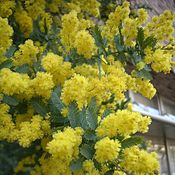 Acacia baileyana Acacia baileyana |
0.02% tryptamine and β-carbolines, in the leaf, Tetrahydroharman[28][36][37] |
| Acacia beauverdiana | Psychoactive[38] Ash used in Pituri.[29] |
 Acacia berlandieri Acacia berlandieri |
DMT, amphetamines, mescaline, nicotine[39] |
 Acacia catechu Acacia catechu |
DMT[40] and other tryptamines in leaf, bark |
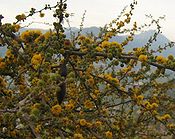 Acacia caven Acacia caven |
Tryptamines |
 Acacia chundra Acacia chundra |
DMT and other tryptamines in leaf, bark |
| Acacia colei | DMT[41] |
| Acacia complanata | 0.3% alkaloids in leaf and stem, almost all N-methyl-tetrahydroharman, with traces of tetrahydroharman, some of tryptamine[42][43][44] |
 Acacia concinna Acacia concinna |
Nicotine[45] |
 Acacia confusa Acacia confusa |
DMT & NMT in leaf, stem & bark 0.04% NMT and 0.02% DMT in stem.[28] Also N,N-dimethyltryptamine N-oxide[46] |
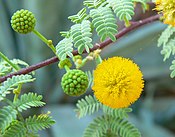 Acacia constricta Acacia constricta |
β-methyl-phenethylamine[31] |
| Acacia coriacea | Ash used in Pituri.[29][47] Not known if psychoactive. |
 Acacia cornigera Acacia cornigera |
Psychoactive,[47] Tryptamines[14] |
 Acacia cultriformis Acacia cultriformis |
Tryptamine, in the leaf, stem[28] and seeds.[34] Phenethylamine in leaf and seeds[34] |
| Acacia cuthbertsonii | Psychoactive[38] |
| Acacia delibrata | Psychoactive[38] |
 Acacia falcata Acacia falcata |
Psychoactive,[38] but less than 0.02% alkaloids[37] |
 Acacia farnesiana Acacia farnesiana |
Traces of 5-MeO-DMT[48] in fruit. β-methyl-phenethylamine, flower.[49] Ether extracts about 2-6% of the dried leaf mass.[30] Alkaloids are present in the bark[50] and leaves.[51] Amphetamines and mescaline also found in tree.[14] |
| Acacia filiciana | Added to Pulque, but not known if psychoactive[47] |
| Acacia floribunda | Tryptamine, phenethylamine,[52] in flowers[34] other tryptamines, phenethylamines[53] |
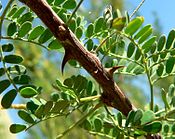 Acacia greggii Acacia greggii |
N-methyl-β-phenethylamine,[31]phenethylamine[7] |
| Acacia harpophylla | Phenethylamine, hordenine at a ratio of 2:3 in dried leaves, 0.6% total[27] |
| Acacia holoserica | Hordenine, 1.2% in bark[27] |
 Acacia horrida Acacia horrida |
Psychoactive[47] |
 Acacia implexa Acacia implexa |
Psychoactive[54] |
| Acacia jurema | DMT, NMT |
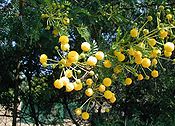 Acacia karroo Acacia karroo |
Psychoactive |
| Acacia kempeana | Used in Pituri, but not known if psychoactive.[47] |
| Acacia kettlewelliae | 1.5[27]-1.88%[55] alkaloids, 92% consisting of phenylethylamine.[27] 0.9% N-methyl-2-
phenylethylamine found a different time.[27] |
| Acacia laeta | DMT, in the leaf[28] |
| Acacia lingulata | Used in Pituri, but not known if psychoactive.[47] |
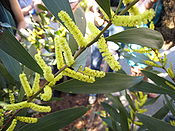 Acacia longifolia Acacia longifolia |
0.2% tryptamine in bark, leaves, some in flowers, phenylethylamine in flowers,[52] 0.2% DMT in plant.[56] Histamine alkaloids.[37] |
| Acacia longifoliavar. sophorae | Tryptamine in leaves, bark[34] |
| Acacia macradenia | Tryptamine[34] |
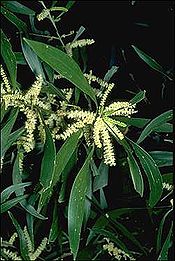 Acacia maidenii Acacia maidenii |
0.6% NMT and DMT in about a 2:3 ratio in the stem bark, both present in leaves[28] |
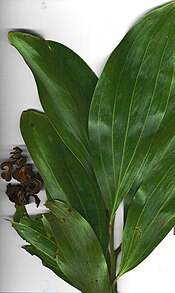 Acacia mangium Acacia mangium |
Psychoactive[47] |
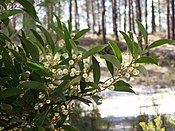 Acacia melanoxylon Acacia melanoxylon |
DMT, in the bark and leaf,[57] but less than 0.02% total alkaloids[37] |
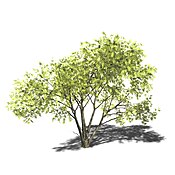 Acacia mellifera Acacia mellifera |
DMT, in the leaf[28] |
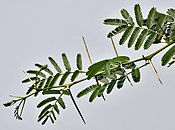 Acacia nilotica Acacia nilotica |
DMT, in the leaf[28] |
| Acacia niloticasubsp. adstringens | Psychoactive, DMT in the leaf |
| Acacia obtusifolia | Tryptamine, DMT, NMT, other tryptamines,[58] 0.4-0.5% in dried bark, 0.07% in branch tips.[59] |
| Acacia oerfota | Less than 0.1% DMT in leaf,[36][60] NMT |
| Acacia penninervis | Psychoactive[38] |
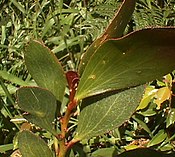 Acacia phlebophylla Acacia phlebophylla |
0.3% DMT in leaf, NMT[28] |
 Acacia podalyriaefolia Acacia podalyriaefolia |
Tryptamine in the leaf,[28] 0.5% to 2% DMT in fresh bark, phenethylamine, trace amounts[52] |
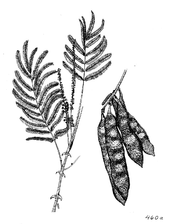 Acacia polyacantha Acacia polyacantha |
DMT in leaf[28] and other tryptamines in leaf, bark |
| Acacia polyacanthassp. campylacantha | Less than 0.2% DMT in leaf, NMT; DMT and other tryptamines in leaf, bark[61] |
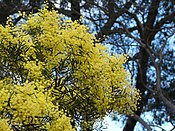 Acacia prominens Acacia prominens |
Phenylethylamine, β-methyl-phenethylamine[27][52] |
| Acacia pruinocarpa | Ash used in Pituri.[29][47] Not known if psychoactive. |
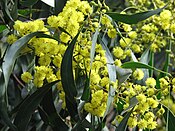 Acacia pycnantha Acacia pycnantha |
Ash used in Pituri,[47] but less than 0.02% total alkaloids.[37] Not known if psychoactive. |
 Acacia retinodes Acacia retinodes |
DMT, NMT,[62] nicotine,[14] but less than 0.02% total alkaloids found[37] |
 Acacia rigidula Acacia rigidula |
DMT, NMT, tryptamine, amphetamines, mescaline, nicotine and others[63] |
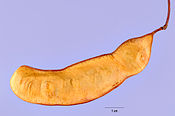 Acacia roemeriana Acacia roemeriana |
β-methyl-phenethylamine[31] |
 Acacia rose Acacia rose |
Acacia rose blooming in the garden.[28] |
 Acacia salicina Acacia salicina |
Ash used in Pituri.[29][47] Not known if psychoactive. |
 Acacia sassa Acacia sassa |
Psychoactive[47] |
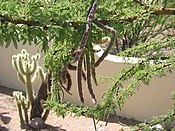 Acacia schaffneri Acacia schaffneri |
β-methyl-phenethylamine, Phenethylamine[7] Amphetamines and mescaline also found.[14] |
| Acacia schottii | β-methyl-phenethylamine[31] |
 Acacia senegal Acacia senegal |
Less than 0.1% DMT in leaf,[28] NMT, other tryptamines. DMT in plant,[49] DMT in bark.[34] |
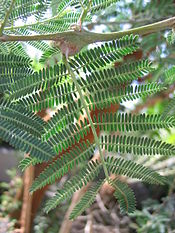 Acacia seyal Acacia seyal |
DMT, in the leaf.[28] Ether extracts about 1-7% of the dried leaf mass.[30] |
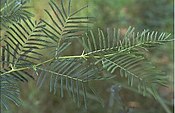 Acacia sieberiana Acacia sieberiana |
DMT, in the leaf[28] |
 Acacia simplex Acacia simplex |
DMT and NMT, in the leaf, stem and trunk bark, 0.81% DMT in bark, MMT[28][64] |
| Acacia taxensis | β-methyl-phenethylamine[31] |
 Acacia tortilis Acacia tortilis |
DMT, NMT, and other tryptamines[58] |
| Acacia vestita | Tryptamine, in the leaf and stem,[28] but less than 0.02% total alkaloids[37] |
| Acacia victoriae | Tryptamines, 5-MeO-alkyltryptamine[34] |
List of acacia species having little or no alkaloids in the material sampled:[37]
0%  C
C  0.02%, C...Concentration of Alkaloids [%]
0.02%, C...Concentration of Alkaloids [%]
- Acacia acinacea
- Acacia baileyana
- Acacia decurrens
- Acacia dealbata
- Acacia mearnsii
- Acacia drummondii
- Acacia elata
- Acacia falcata
- Acacia leprosa
- Acacia linearis
- Acacia melanoxylon
- Acacia pycnantha
- Acacia retinodes
- Acacia saligna
- Acacia stricta
- Acacia verticillata
- Acacia vestita
Cyanogenic glycosides
Nineteen different species of Acacia in the Americas contain cyanogenic glycosides, which, if exposed to an enzyme which specifically splits glycosides, can release hydrogen cyanide (HCN) in the acacia "leaves."[65] This sometimes results in the poisoning death of livestock.
If fresh plant material spontaneously produces 200 ppm or more HCN, then it is potentially toxic. This corresponds to about 7.5 μmol HCN per gram of fresh plant material. It turns out that, if acacia "leaves" lack the specific glycoside-splitting enzyme, then they may be less toxic than otherwise, even those containing significant quantities of cyanic glycosides.[37]
Some Acacia species containing cyanogens:
- Acacia erioloba
- Acacia cunninghamii
- Acacia obtusifolia
- Acacia sieberiana
- Acacia sieberiana var. woodii[66]
Species
There are over 1,300 species of Acacia. See List of Acacia species for a more complete listing.
Famous acacia
Perhaps the most famous acacia is the Arbre du Ténéré in Niger. The reason for the tree's fame is that it used to be the most isolated tree in the world, approximately 400 km (249 mi) from any other tree. The tree was knocked down by a truck driver in 1973.
Identification gallery
Flowers
|
Acacia saligna Side, Turkey
|
|||
|
Acacia schinoides Australian National Botanic Gardens
|
Acacia tetragonophylla Geelong Botanic Gardens, Victoria, Australia
|
Acacia pennata in Talakona forest, in Chittoor District of Andhra Pradesh, India |
Bark
|
Acacia aneura Bark
|
Acacia berlandieri Bark
|
Acacia collinsii Bark
|
|
|
Acacia confusa Bark, Hawaii, USA
|
|||
|
Acacia greggii Bark
|
Acacia pennata trunk in Talakona forest, in Chittoor District of Andhra Pradesh, India. |
Foliage
|
Acacia collinsii Foliage
|
Acacia concinna Foliage
|
Acacia denticulosa Foliage
|
|
|
Acacia karroo Foliage
|
Acacia leprosa Foliage
|
Acacia pennata in Talakona forest, in Chittoor District of Andhra Pradesh, India. |
Seed pods
Seeds
Thorns
|
Acacia pennata in Talakona forest, in Chittoor District of Andhra Pradesh, India. |
Tree
Wood
See also
Notes
- ^ Genus: Acacia Mill. - Germplasm Resources Information Network (GRIN)
- ^ "Acacia nilotica (acacia)". Plants & Fungi. Royal Botanic Gardens, Kew. http://www.kew.org/plants-fungi/Acacia-nilotica.htm. Retrieved 2010-01-28.
- ^ Quattrocchi, Umberto (2000). CRC World Dictionary of Plant Names. 1 A-C. CRC Press. p. 6. ISBN 9780849326752. http://books.google.com/?id=esMPU5DHEGgC.
- ^ Singh, Gurcharan (2004). Plant Systematics: An Integrated Approach. Science Publishers. pp. 445. ISBN 1578083516. http://books.google.com/?id=In_Lv8iMt24C.
- ^ J Clemens, PG Jones, NH Gilbert (1977). "Effect of seed treatments on germination in Acacia". Australian Journal of Botany 25 (3): 269–267. doi:10.1071/BT9770269. http://www.publish.csiro.au/nid/65/paper/BT9770269.htm.
- ^ "Evolutionary change from induced to constitutive expression of an indirect plant resistance : Abstract : Nature". www.nature.com. http://www.nature.com/nature/journal/v430/n6996/abs/nature02703.html. Retrieved 2008-04-20.
- ^ a b c d Chemistry of Acacias from South Texas
- ^ "Seggiano Honeys". www.seggiano.co.uk. http://seggiano.co.uk/products/10honey/honey.html. Retrieved 2008-05-05.
- ^ [1]
- ^ Richard Pankhurst, An Introduction to the Medical History of Ethiopia (Trenton: Red Sea Press, 1990), p. 97
- ^ An OCR'd version of the US Dispensatory by Remington and Wood, 1918.
- ^ World Wide Wattle
- ^ Excerpt from A Consumer's Dictionary of Cosmetic Ingredients: Fifth Edition (Paperback) Amazon.com
- ^ a b c d e Naturheilpraxis Fachforum (German)
- ^ Easton's Bible Dictionary: Bush
- ^ a b c d Purdue University
- ^ a b c d e Google Books Select Extra-tropical Plants Readily Eligible for Industrial Culture Or Naturalization By Ferdinand von Mueller
- ^ a b c d Plants for a Future Database
- ^ Maugh, T.H.II. (2009-04-24). "New species of tree identified in Ethiopia". Los Angeles Times. http://www.latimes.com/news/nationworld/nation/la-sci-tree25-2009apr25,0,402549.story. Retrieved 2008-04-24.
- ^ Aussie Fantom
- ^ a b c d e f g h i j k l The timber properties of Acacia species and their uses
- ^ a b c d FAO
- ^ Timber hardness and durability table, Timber Merchants Association (Vic., Australia)
- ^ Barr, D. A., and Atkinson, W. J. (1970). "Stabilization of coastal sands after mining". J. Soil Conserv. Serv. N.S.W. 26: 89–105..
- ^ http://www.hear.org/pier/species/acacia_mearnsii.htm
- ^ Lycaeum
- ^ a b c d e f g Fitzgerald, J.S. Alkaloids of the Australian Legumuminosae -- The Occurrence of Phenylethylame Derivatives in Acacia Species, Aust. J . Chem., 1964, 17, 160-2.
- ^ a b c d e f g h i j k l m n o p q Shaman Australis
- ^ a b c d e Duboisia hopwoodii - Pituri Bush - Solanaceae - Central America
- ^ a b c Wattle Seed Workshop Proceedings 12 March 2002, Canberra March 2003 RIRDC Publication No 03/024, RIRDC Project No WS012-06
- ^ a b c d e f Glasby, John Stephen (1991). Dictionary of Plants Containing Secondary Metabolites. CRC Press. pp. 2. ISBN 0850664233. http://books.google.com/?id=te53VV5u8YMC&pg=RA1-PA2&dq=acacia+alkaloids.
- ^ English Title: Nutritive value assessment of the tropical shrub legume Acacia angustissima: anti-nutritional compounds and in vitro digestibility. Personal Authors: McSweeney, C. S., Krause, D. O., Palmer, B., Gough, J., Conlan, L. L., Hegarty, M. P. Author Affiliation: CSIRO Livestock Industries, Long Pocket Laboratories, 120 Meiers Road, Indooroopilly, Qld 4068, Australia. Document Title: Animal Feed Science and Technology, 2005 (Vol. 121) (No. 1/2) 175-190
- ^ Maya Ethnobotanicals
- ^ a b c d e f g h Acacia (Polish)
- ^ Lycaeum
- ^ a b www.serendipity.com
- ^ a b c d e f g h i Chemotaxonomie der Pflanzen By Robert Hegnauer
- ^ a b c d e www.bushfood.net
- ^ Ask Dr. Shulgin Online: Acacias and Natural Amphetamine
- ^ Sacred Elixirs
- ^ www.abc.net.au
- ^ Acacia Complanata Phytochemical Studies
- ^ Lycaeum -- Acacias and Entheogens
- ^ Lycaeum
- ^ SBEPL
- ^ NMR spectral assignments of a new chlorotryptamine alkaloid and its analogues from Acacia confusa Malcolm S. Buchanan, Anthony R. Carroll, David Pass, Ronald J. Quinn Magnetic Resonance in Chemistry Volume 45, Issue 4 , Pages359 - 361. John Wiley & Sons, Ltd.
- ^ a b c d e f g h i j k Index of Rätsch, Christian. Enzyklopädie der psychoaktiven Pflanzen, Botanik, Ethnopharmakologie und Anwendungen, 7. Auflage. AT Verlag, 2004, 941 Seiten. ISBN 3855025703 at [2]
- ^ Lycaeum
- ^ a b Dr. Duke's Phytochemical and Ethnobotanical Databases
- ^ www.bpi.da.gov.ph
- ^ Purdue University
- ^ a b c d Hegnauer, Robert (1994). Chemotaxonomie der Pflanzen. Springer. pp. 500. ISBN 3764329793. http://books.google.com/?id=9fDv1RYqIRkC&dq=chemotaxonomie+der+pflanzen&printsec=frontcover.
- ^ Lycaeum (Acacia floribunda)
- ^ wiki.magiskamolekyler.org (Swedish)
- ^ Acacia kettlewelliae
- ^ Lycaeum Acacia longifolia
- ^ extentech.sheetster.com
- ^ a b wiki.magiskamolekyler.org (Swedish)
- ^ Acacia obtusifolia Phytochemical Studies
- ^ Plants Containing DMT (German)
- ^ Hortipedia
- ^ Pflanzentabelle APB (German)
- ^ Magiska Molekylers wiki
- ^ Arbeitsstelle für praktische Biologie (APB)
- ^ Cyanogenic Glycosides in Ant-Acacias of Mexico and Central America David S. Seigler, John E. Ebinger The Southwestern Naturalist, Vol. 32, No. 4 (December 9, 1987), pp. 499-503 doi:10.2307/3671484
- ^ FAO Kamal M. Ibrahim, The current state of knowledge on Prosopis juliflora...
General references
- Clement, B.A., Goff, C.M., Forbes, T.D.A. Toxic Amines and Alkaloids from Acacia rigidula, Phytochem. 1998, 49(5), 1377.
- Shulgin, Alexander and Ann, TiHKAL the Continuation. Transform Press, 1997. ISBN 0-9630096-9-9
| License | http://creativecommons.org/licenses/by-sa/3.0/ |
| Rights holder/Author | Wikipedia |
| Source | http://en.wikipedia.org/w/index.php?title=Acacia&oldid=408133826 |
Faidherbia albida is the only species within this genus. Its distribution is over drier parts of southern sub-Saharan Africa (chiefly tropical and East Africa); in South Africa the taxon is confined to watercourses in northern KwaZulu-Natal, Mpumalandga and the Limpopo Province. In 2010, C.Michael Hogan has located the species along some of the seasonally dry riverbeds in the western-central Namib Desert, where it is a favourite food source of the Desert Elephant.
| License | http://creativecommons.org/licenses/by-nc/3.0/ |
| Rights holder/Author | C. Michael Hogan, C. Michael Hogan |
| Source | No source database. |
Notes: Introduced and planted
"
Wood is very hard, durable and preferred for agricultural implements. Cattle feed on the fruits.
"
| License | http://creativecommons.org/licenses/by/3.0/ |
| Rights holder/Author | Keystone Foundation, India Biodiversity Portal |
| Source | http://indiabiodiversity.org/species/show/264254 |
Southeastern United States; on the lower slopes of the Appalachian Mountains, with separate outliers north along the slopes and forest edges of southern Illinois, Indiana, and Missouri
Foodplant / saprobe
immersed in bark, in clusters of 2-5, stromatic pseudothecium of Aglaospora profusa is saprobic on dead twig of Robinia pseudoacacia
Remarks: season: 10-1
In Great Britain and/or Ireland:
Foodplant / parasite
fruitbody of Agrocybe cylindracea parasitises branch of Robinia pseudoacacia
Other: minor host/prey
Foodplant / pathogen
Armillaria mellea s.l. infects and damages Robinia pseudoacacia
Foodplant / internal feeder
larva of Bruchidius cisti feeds within pod wall of Robinia pseudoacacia
Remarks: Other: uncertain
Plant / associate
adult of Bruchidius varius is associated with Robinia pseudoacacia
Remarks: season: (late 7-early 10, late 4)5-6
Fungus / saprobe
pycnidium of Camarosporium coelomycetous anamorph of Camarosporium robiniae is saprobic on dead wood of Robinia pseudoacacia
Foodplant / saprobe
clustered or linear, subiculate pseudothecium of Cucurbitaria elongata is saprobic on dead twig of Robinia pseudoacacia
Foodplant / saprobe
immersed, plurilocular stroma of Cytosporina coelomycetous anamorph of Cytosporina ludibunda p.p. (Robinia form) is saprobic on branch of Robinia pseudoacacia
Foodplant / saprobe
immersed, in small groups perithecium of Diaporthe oncostoma is saprobic on dead twig of Robinia pseudoacacia
Remarks: season: 12-2
Foodplant / saprobe
fruitbody of Ganoderma australe is saprobic on dead trunk of Robinia pseudoacacia
Foodplant / parasite
fruitbody of Ganoderma lucidum parasitises live stump of Robinia pseudoacacia
Other: minor host/prey
Foodplant / saprobe
sometimes effuse Gliocladium anamorph of Gliocladium roseum is saprobic on wood of Robinia pseudoacacia
Foodplant / saprobe
fruitbody of Meripilus giganteus is saprobic on dead trunk (large) of Robinia pseudoacacia
Fungus / parasite
Microsphaera pseudacaciae parasitises Robinia pseudoacacia
Foodplant / saprobe
stromatic perithecium of Nectria pallidula is saprobic on dead twig of Robinia pseudoacacia
Remarks: season: 8-1
Foodplant / open feeder
larva of Nematus tibialis grazes on leaf of Robinia pseudoacacia
Other: sole host/prey
Foodplant / gall
larva of Obolodiplosis robiniae causes gall of rolled leaf margin of Robinia pseudoacacia
Foodplant / parasite
fruitbody of Perenniporia fraxinea parasitises live trunk (base) of Robinia pseudoacacia
Other: minor host/prey
Foodplant / spot causer
amphigenous, numerous, very small, scattered, immersed, pallid acervulus of Phloeospora coelomycetous anamorph of Phloeospora robiniae causes spots on live, fading leaf of Robinia pseudoacacia
Remarks: season: autumn
Foodplant / feeds on
gregarious to linearly arranged, covered, then raising and bursting pycnidium of Phomopsis coelomycetous anamorph of Phomopsis oncostoma feeds on branch of Robinia pseudoacacia
Remarks: season: 1-7
Foodplant / feeds on
crowded or solitary, embedded in rows, then erumpent pycnidium of Phomopsis coelomycetous anamorph of Phomopsis petiolorum feeds on branch of Robinia pseudoacacia
Foodplant / gall
Phytoplasma (ined) causes gall of twig of Robinia pseudoacacia
Foodplant / saprobe
fruitbody of Rigidoporus ulmarius is saprobic on dead, white-rotted stump (large) of Robinia pseudoacacia
Foodplant / pathogen
Robinia Mosaic virus infects and damages mosiaced, deformed leaf of Robinia pseudoacacia
Foodplant / hemiparasite
haustorium of Viscum album is hemiparasitic on branch of Robinia pseudoacacia
Within its native range, black locust generally flowers from April to June ([165,261,311,356], review by [167]), though one source states it may flower as early as February in the Southeast [97].
In its nonnative range, flowering occurs mostly from May to June in the Pacific Northwest [156], California [239], the Southwest [325], Northeast and Canada [123], and Great Plains [128,313]. Earlier flowering occurs from March to May in north-central Texas [85], while later flowering occurs in some parts of New England, extending into July [292]. In the uplands of the Adirondacks, flowering generally occurs only in June [190].
Fruit begins ripening as early as July in the Carolinas [261] or August in Arkansas [165], and ripening extends into November [165,261]. In the Southwest, fruit ripens from September to October [325]. Black locust seeds persist through the winter [113,165], though dispersal is described as occurring from September to April in both its native (review by [167]) and nonnative [325] ranges.
There are 2 primary insects inflicting damage on black locust: locust leaf miner and black locust borer. The leaf miner attacks the tree in spring, turning the leaves brown by mid-summer or early fall. Overall tree growth is impacted, but not seriously. The larvae
of the locust borer carve tunnels through the trunk of the tree, weakening it enough for wind breakage. Planting on good quality sites or in conjunction with other hardwood species and shading trunks will discourage infestation by locust borers. Heart rot is the only noteworthy disease effecting black locust.
United States
Origin: Native
Regularity: Regularly occurring
Currently: Absent
Confidence: Confident
| License | http://creativecommons.org/licenses/by-nc/3.0/ |
| Rights holder/Author | NatureServe |
| Source | http://explorer.natureserve.org/servlet/NatureServe?searchName=Acacia+tortuosa |
United States
Origin: Exotic
Regularity: Regularly occurring
Currently: Unknown/Undetermined
Confidence: Confident
| License | http://creativecommons.org/licenses/by-nc/3.0/ |
| Rights holder/Author | NatureServe |
| Source | http://explorer.natureserve.org/servlet/NatureServe?searchName=Parkinsonia+aculeata |
